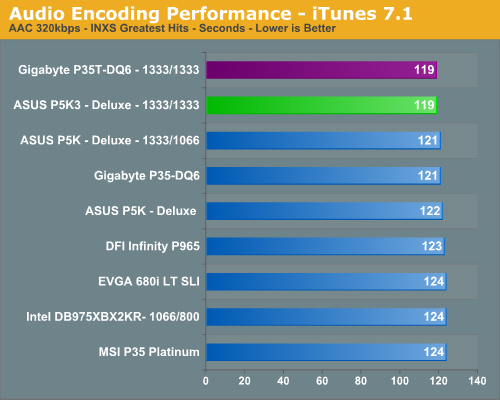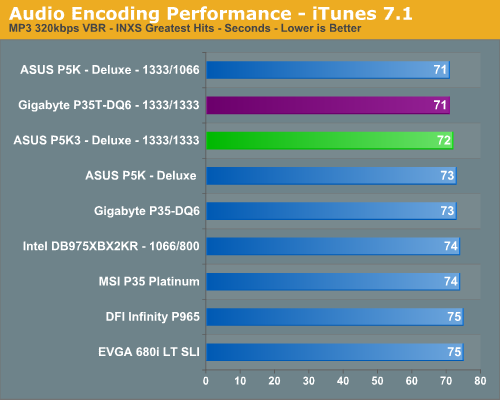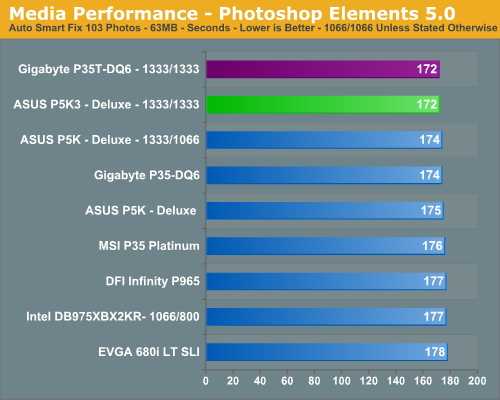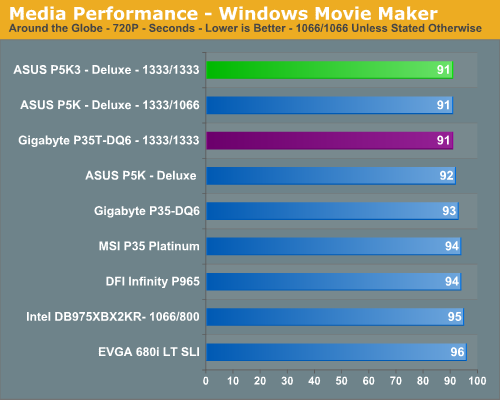Gigabyte GA-P35T-DQ6: DDR3 comes a knocking, again
by Gary Key on May 30, 2007 2:00 AM EST- Posted in
- Motherboards
Audio Encoding Performance
Our previous audio test suite consisted of Exact Audio Copy v095.b4 and LAME 3.98a3. We did run these tests with basically the same results but we will now utilize iTunes 7.1 as it is one of the most utilized audio applications available due to the immense popularity of the iPod. As in previous articles, we are using the INXS Greatest Hits CD for testing, which contains 16 tracks totaling 606MB of songs.
Our two audio tests have us utilizing iTunes to convert our WAV files into ACC or MP3 compatible formats. We utilize the 320kbps setting for both tests with the MP3 test also utilizing the variable bit rate option.


We see iTunes favoring boards with excellent CPU throughput and memory bandwidth with the 1333FSB showing a slight advantage in this test. All of the P35 boards place ahead of the older chipsets, with the exception of the MSI board. As we have mentioned already, the MSI board appears to be a couple of BIOS updates behind the Gigabyte and ASUS offerings right now, so we expect its scores to improve greatly in the next BIOS update.
Multimedia Performance
We will take a brief look at general multimedia performance with our test suite for that includes Adobe Photoshop CS3, Adobe Photoshop Elements 5.0, and Windows Movie Maker.
We utilize the widely available Retouch Artists Photoshop Speed Test for measuring platform performance in Adobe's Photoshop CS3. The benchmark applies a number of actions to a test image while we measure the total time elapsed during the active portion of the test. We set history states to 1, cache levels to 4, and CS3 is configured to make use of all available system memory. The scores reported include the full conversion process and are represented in seconds, with lower numbers indicating better performance.

The results are in alignment with the majority of our tests to date. The 1333FSB platforms hold an advantage, although minor, in tests where CPU throughput and memory bandwidth/latency are important. The Gigabyte P35T finishes right in front of the ASUS P5K3 thanks to slightly better latencies and memory bandwidth.
Our next test is one recommended by Intel, but the test itself appears to be fair for all platforms and results are very repeatable. This test simply measures the amount of time required to fix and optimize 103 different photos weighing in at 63MB. Time is measured in seconds and lower times indicate better performance.

This test not only stresses the CPU/memory pipeline but also gives the storage systems a good workout. However, our results basically mirror those of our other media tests with the 1333FSB boards finishing slightly ahead and the Gigabyte/ASUS boards fighting for first place in the DDR3 setups.
Next on the list is our Windows Movie Maker test that will meld our world vacation content (recorded off TV) into a newly downloadable file that can be viewed on our Xbox 360 in a pleasing 720P format. The values reported are in seconds for the conversion time, with lower numbers being better.

The new Intel P35 DDR2 platform boards come out on top in this test, with the DDR3 1333FSB offerings providing better performance than the other chipsets due to better memory bandwidth while still providing very good latencies. The total spread is 5.5% here, showing that the BIOS optimizations of our P35 boards can certainly be noticed in video encoding operations.
Our previous audio test suite consisted of Exact Audio Copy v095.b4 and LAME 3.98a3. We did run these tests with basically the same results but we will now utilize iTunes 7.1 as it is one of the most utilized audio applications available due to the immense popularity of the iPod. As in previous articles, we are using the INXS Greatest Hits CD for testing, which contains 16 tracks totaling 606MB of songs.
Our two audio tests have us utilizing iTunes to convert our WAV files into ACC or MP3 compatible formats. We utilize the 320kbps setting for both tests with the MP3 test also utilizing the variable bit rate option.


We see iTunes favoring boards with excellent CPU throughput and memory bandwidth with the 1333FSB showing a slight advantage in this test. All of the P35 boards place ahead of the older chipsets, with the exception of the MSI board. As we have mentioned already, the MSI board appears to be a couple of BIOS updates behind the Gigabyte and ASUS offerings right now, so we expect its scores to improve greatly in the next BIOS update.
Multimedia Performance
We will take a brief look at general multimedia performance with our test suite for that includes Adobe Photoshop CS3, Adobe Photoshop Elements 5.0, and Windows Movie Maker.
We utilize the widely available Retouch Artists Photoshop Speed Test for measuring platform performance in Adobe's Photoshop CS3. The benchmark applies a number of actions to a test image while we measure the total time elapsed during the active portion of the test. We set history states to 1, cache levels to 4, and CS3 is configured to make use of all available system memory. The scores reported include the full conversion process and are represented in seconds, with lower numbers indicating better performance.

The results are in alignment with the majority of our tests to date. The 1333FSB platforms hold an advantage, although minor, in tests where CPU throughput and memory bandwidth/latency are important. The Gigabyte P35T finishes right in front of the ASUS P5K3 thanks to slightly better latencies and memory bandwidth.
Our next test is one recommended by Intel, but the test itself appears to be fair for all platforms and results are very repeatable. This test simply measures the amount of time required to fix and optimize 103 different photos weighing in at 63MB. Time is measured in seconds and lower times indicate better performance.

This test not only stresses the CPU/memory pipeline but also gives the storage systems a good workout. However, our results basically mirror those of our other media tests with the 1333FSB boards finishing slightly ahead and the Gigabyte/ASUS boards fighting for first place in the DDR3 setups.
Next on the list is our Windows Movie Maker test that will meld our world vacation content (recorded off TV) into a newly downloadable file that can be viewed on our Xbox 360 in a pleasing 720P format. The values reported are in seconds for the conversion time, with lower numbers being better.

The new Intel P35 DDR2 platform boards come out on top in this test, with the DDR3 1333FSB offerings providing better performance than the other chipsets due to better memory bandwidth while still providing very good latencies. The total spread is 5.5% here, showing that the BIOS optimizations of our P35 boards can certainly be noticed in video encoding operations.










22 Comments
View All Comments
yzkbug - Wednesday, May 30, 2007 - link
Will we ever see boards supporting both DDR2 and DDR3 memory? It would be nice to be able to run DDR2 for now, and switch to DDR3 in the future without buying a new mobo.Stele - Friday, June 1, 2007 - link
There's already at least one in existence - the Asus P5KC. Check it out http://www.asus.com/products.aspx?l1=3&l2=11&a...">here.It would be interesting if Anandtech could get hold of this board and see if having support for both memory types sacrifices fine tuning and hence performance/overclocking capability by a measurable degree.
slayerized - Wednesday, May 30, 2007 - link
I know it is a bit premature, but do you have n estimate on the targeted price points for these boards and ddr3 memory modules?gigahertz20 - Wednesday, May 30, 2007 - link
You can already buy the Asus P5K Deluxe for $225 from here.http://www.xpcgear.com/p5kdeluxe.html">http://www.xpcgear.com/p5kdeluxe.html
My guess is once Newegg and some other places get them in hopefully around $200 or below but maybe not. They will be expensive at first.
xsilver - Thursday, May 31, 2007 - link
are p35 boards recommended for midrange overclocking systems just yet?a gigabyte ds3 + e6320 vs. a asus p5k + e4400 combo; which system is likly to have better performance after OC?
Sunrise089 - Wednesday, May 30, 2007 - link
The above comments reminded me of something many reviews have said recently - that "additional airflow needed to OC" line. What exactly does that mean? Does it simply mean airflow inside the case, as in you first tested with so case fans at all, and had to add some? Or does it mean you added some sort of motherboard specific additional cooling? If the latter, a motherboard that does not require such an added part would be much more appealing.Googer - Wednesday, May 30, 2007 - link
Good Article. But where are the disk and I/O benchmarks?Treripica - Wednesday, May 30, 2007 - link
What the hell is a niggle?johnsonx - Thursday, May 31, 2007 - link
a 'niggle' is a minor complaint, or perhaps a complaint about a small detail. It's completely unrelated to another word like that with an 'r' at the end.TallBill - Wednesday, May 30, 2007 - link
All applications were run with administer privileges.